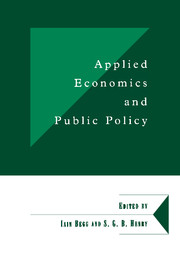Book contents
- Frontmatter
- Contents
- List of figures
- List of tables
- List of contributors
- Foreword
- 1 Introduction
- Part One MODELLING AND FORECASTING METHODS
- 2 Large-scale energy–environment–economy modelling of the European Union
- 3 Measurement errors and data estimation: the quantification of survey data
- 4 Social accounting matrices and applied general equilibrium models
- 5 The development of econometric methods at the DAE
- Part Two COMBINING DATA AND ANALYTIC TECHNIQUES
- Part Three USING MODELS TO GUIDE POLICY
- Bibliography
- Index
5 - The development of econometric methods at the DAE
from Part One - MODELLING AND FORECASTING METHODS
Published online by Cambridge University Press: 06 July 2010
- Frontmatter
- Contents
- List of figures
- List of tables
- List of contributors
- Foreword
- 1 Introduction
- Part One MODELLING AND FORECASTING METHODS
- 2 Large-scale energy–environment–economy modelling of the European Union
- 3 Measurement errors and data estimation: the quantification of survey data
- 4 Social accounting matrices and applied general equilibrium models
- 5 The development of econometric methods at the DAE
- Part Two COMBINING DATA AND ANALYTIC TECHNIQUES
- Part Three USING MODELS TO GUIDE POLICY
- Bibliography
- Index
Summary
Introduction
The history of econometrics is now a flourishing little sub-discipline: see, for instance, Epstein, 1987; Pesaran, 1987b; Morgan, 1990; de Marchi and Gilbert, 1989; Qin, 1993; and Keuzenkamp and Magnus, 1995. In addition, Econometric Theory regularly publishes interviews with the pioneers of econometrics. This interest is as much methodological as historical, since the pioneers of econometrics had to confront very fundamental issues which remain a matter of dispute today. In this history the DAE plays a central role. Epstein (1987, p. 142) says that ‘the influence of this English work was comparable to that of the Cowles Commission in establishing directions for econometric research.’ The English work was initially done at the DAE, but Epstein, like Gilbert (1986), sees leadership of the English school of econometrics leaving Cambridge for London in the 1950s. Like Cowles, after a period of developing econometric methods the DAE turned its attention to other topics.
There were many achievements in econometric methods during the first decade of the DAE, but two were of particular importance. The establishment of the text-book, single-equation, time-series regression framework with its standard notation and tests as the work-horse of econometrics, and the use of tight economic theory in estimation of consumer demand models, exemplified by Stone (1954b). Of the DAE work, Gilbert (1986) says: ‘Demand analysis is widely perceived by the economics profession as being one of the great success stories of postwar applied econometrics. This is to a large extent because of the close relationship between economic theory and econometric practice apparent in work in this area…’.
- Type
- Chapter
- Information
- Applied Economics and Public Policy , pp. 88 - 104Publisher: Cambridge University PressPrint publication year: 1998
- 10
- Cited by



